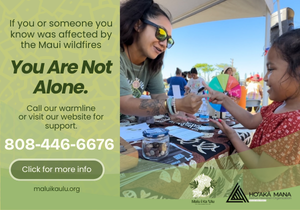Everything Ulu
Community Contributed
By Glenn I. Teves, County Extension Agent, UH CTAHR
Breadfruit is an important part of an agroforestry system and essential food plants in many Pacific islands. On May 17, a breadfruit workshop held at the UH Maui, Molokai Farm was attended by 46 residents and covered all aspects of ulu from history to growing to tasting.
Dr. Diane Ragone shared decades of work with ulu, starting as a graduate student at UH College of Tropical Agriculture and Human Resources studying ulu, and the last 25 years at the Pacific Tropical Botanical Gardens Breadfruit Institute on Kauai. She travelled throughout the Pacific documenting and collecting breadfruit, and with root cuttings of more than 300 varieties, she was able to propagate and grow to maturity over 170 of them established at Kahanu Gardens in Hana.
She noted a drastic shift from the native diet to the western diet and resulting health maladies, similar to what see in our own community today, such as diabetes, hypertension, heart diseases, and obesity. She also talked about the evolution of ulu from a seedy fruit in Micronesia to a seedless variety developed through human selection in Polynesia.
Because seedless ulu is difficult to propagate, the Institute partnered with researchers at Global Breadfruit and Cultivaris to refine the micropropagation of ulu to produce millions of keiki. Ulu is presently being planted in many tropical areas across the globe, including Africa, South America, and also in Pakistan, where they’ll be used to make flat bread, an essential starch in their diet.
Ian Cole, ulu collection manager at the Kahanu Gardens, spoke about the care of ulu trees, such as placement of a tree in a farm or yard. Pruning strategies include cutting the top of the tree to keep the fruits within picking range and pruning every branch to keep the plant compact. Don’t cut the branch flush to the truck or main branch because it may cause die-off or disease.
In arid areas like Ho`olehua, ulu require constant irrigation until it establishes itself and occasional deep watering when established. The roots will only thrive where there’s water.
John Cadman left his job as food service manager at Kamehameha Schools, Maui Campus to dive into creating ulu products called Pono Pies. He manufactures ulu products in Kihei and sometimes finds it difficult getting enough ulu, and may need some ulu from Molokai. He also sells cooked ulu in bulk to restaurants, but his jewel is his Pono Pies, including a velvety chocolate swirl similar to a creamy cheese cake with ulu, Maui coffee and chocolate, and a crust with nuts and chopped coconut. What a treat!
John also brought humus he prepared with ulu, olena, a little chili pepper, and other ingredients. He hopes to refine his products to the point where the ingredients over 95 percent locally grown. His presentation showcased the unlimited uses of ulu.
Breadfruit plants of the Tahitian variety Pua`a were also shared with participants to promote the growth and consumption of ulu as an important starch on Molokai. Two books on ulu were sold and can be found on the website below. The ulu workshop also commemorated the 100th anniversary of the Cooperative Extension Service. Our office is located next to the Ho`olehua Post Office.
“Plant A Tree Of Life – Grow `Ulu” is a program of Ho`oulu ka `Ulu, a project of the Breadfruit Institute at the National Tropical Botanical Garden and the Hawaii Homegrown Food Network to revitalize breadfruit in Hawaii, breadfruit.org and breadfruit.info.













Don't have a Molokai Dispatch ID?
Sign up is easy. Sign up now
You must login to post a comment.
Lost Password